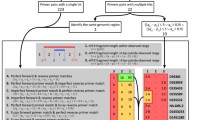Abstract
We amplified, via PCR, DNA segments from intron 1 of the tyrosine hydroxylase gene (TH01) and intron 40 of the von Willebrand factor gene (VWA) in ten nonhuman primate genera. In humans both introns contain polymorphic microsatellites with tetrameric repeats. Compared to the allelic ranges in human populations relatively short repeat arrays could be detected for the nonhuman primates typed, presumably reflecting an ancient precursor state at both microsatellite loci. Furthermore, our results provide evidence for an association of the average number of repeats present in different primate genera and their divergence time from man. DNA sequencing of VWA orthologues revealed a relatively high variability in the arrangement of repeats in the 5′-repeat arrays, the generation of which could probably be explained by polar mutational events.
Similar content being viewed by others
References
Allen CA, Graves G, Budowle B (1989) Polymerase chain reaction amplification products separated on rehydratable polyacrylamide gels and stained with silver. Biotechniques 7:736–744
Andrews P (1985) Improved timing of hominoid evolution with a DNA clock. Nature 314:498–499
Andrews P (1992) Evolution and environment in the Hominoidea. Nature 360:641–646
Armour JAL, Crosier M, Jeffreys AJ (1992) Human minisatellite alleles detectable only after PCR amplification. Genomics 12:116–124
Bowcock AM, Ruiz-Linares A, Tomfohrde J, Minch E, Kidd JR, Cavalli-Sforza LL (1994) High resolution of human evolutionary trees with polymorphic microsatellites. Nature 368:455–457
Brinkmann B, Rand S, Wiegand P (1991) Population and family data of RFLP's using selected single- and multi-locus systems. Int J Legal Med 104:81–86
Budowle B, Chakraborty R, Giusti AM, Eisenberg AJ, Allen RC (1991) Analysis of the variable number of tandem repeat locus D1S80 by the polymerase chain reaction followed by high resolution polyacrylamide gel electrophoresis. Am J Hum Genet 48:137–144
Chakraborty R, Daiger S (1991) Polymorphisms at VNTR loci suggest homogeneity of the white population of Utah. Hum Biol 63:571–587
Edwards A, Civitello A, Hammond HA, Caskey CT (1991) DNA typing and genetic mapping with trimeric and tetrameric tandem repeats. Am J Hum Genet 49:746–756
Edwards A, Hammond HA, Jin L, Caskey CT, Chakraborty R (1992) Genetic variation at five trimeric and tetrameric tandem repeat loci in four human population groups. Genomics 12:241–253
Gray IC, Jeffreys AJ (1991) Evolutionary transience of hypervariable minisatellites in man and the primates. Proc R Soc Lond [Biol] 243:241–253
Harding RM, Boyce AJ, Clegg JB (1992) The evolution of tandemly repetitive DNA: recombination rules. Genetics 132:847–859
Jeffreys AJ, Tamaki K, MacLeod A, Monckton DG, Neil DL, Armour JAL (1994) Complex gene conversion events in germline mutation at human minisatellites. Nature Genet 6:136–145
Kimpton C, Walton A, Gill P (1992) A further tetranucleotide repeat polymorphism in the vWF gene. Hum Mol Genet 1:287
Kimura M, Ohta T (1978) Stepwise mutation model and distribution of allele frequencies in a finite population. Proc Natl Acad Sci USA 75:2868–2872
Koop BF, Goodman M, Xu P, Chan K, Slighton JL (1986) Primate n-globin DNA sequences and man's place among the great apes. Nature 319:234–237
Martin RD (1993) Primate origins: plugging the gaps. Nature 363:223–234
Möller A, Meyer E, Brinkmann B (1994a) Different types of structural variation in STRs: HumFES/FPS, HumVWA and HumD21S11. Int J Legal Med 106:319–323
Möller A, Wiegand P, Grüschow C, Seuchter SA, Baur MP, Brinkmann B (1994b) Population data and forensic efficiency values for the STR systems HumVWA, HumMBP and HumFABP. Int J Legal Med 106:183–189
Pena SDJ, Desouza KT, Deandrade M, Chakraborty R (1994) Allelic associations of two polymorphic microsatellites in intron 40 of the human von Willebrand factor gene. Proc Natl Acad Sci USA 91: 723–727
Puers C, Hammond HA, Jin L, Caskey CT, Schumm JW (1993) Identification of repeat sequence heterogeneity at the polymorphic short tandem repeat locus HumTH01 (AATG)n and reassignment of alleles in population analysis by using a locus-specific allelic ladder. Am J Hum Genet 53:953–958
Sambrook J, Fritsch EF, Maniatis T (1989) Molecular cloning: a laboratory manual, 2nd ed. Cold Spring Harbor Laboratory Press, Cold Spring Harbor, NY
Sarich VA, Wilson AC (1967) Immunological time scale for hominid evolution. Science 158:1200–1203
Smith GP (1976) Evolution of repeated DNA sequences by unequal crossover. Science 191:528–535
Tautz D (1993) Notes on the definition and nomenclature of tandemly repetitive DNA sequences. In: Pena SDJ, Chakraborty R, Epplen JT, Jeffreys AJ (eds) DNA fingerprinting: state of the science. Birkhäuser, Basel, pp 21–28
Tautz D, Renz M (1984) Simple sequences are ubiquitous repetitive components of eukaryotic genomes. Nucleic Acids Res 12:4127–4138
Weber JL, May PE (1989) Abundant class of human DNA polymorphisms which can be typed using the polymerase chain reaction. Am J Hum Genet 44:388–396
Wiegand P, Bajanowski T, Brinkmann B (1993) DNA typing of debris from fingernails. Int J Legal Med 106:81–83
Wright S (1949) Genetics of populations. In: Encyclopaedia Britannica, 14th ed. pp 111–112
Author information
Authors and Affiliations
Additional information
Correspondence to: B. Brinkmann
Rights and permissions
About this article
Cite this article
Meyer, E., Wiegand, P., Rand, S.P. et al. Microsatellite polymorphisms reveal phylogenetic relationships in primates. J Mol Evol 41, 10–14 (1995). https://doi.org/10.1007/BF00174036
Received:
Accepted:
Issue Date:
DOI: https://doi.org/10.1007/BF00174036




